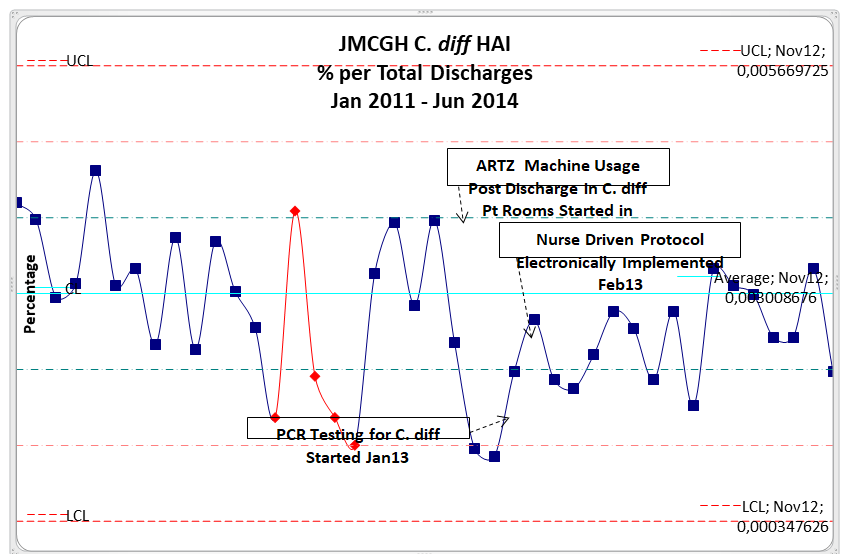There are myriads of infections prevalent in healthcare settings. As a matter of fact, the rising rates of both mortality and morbidity have been attributed to the spread of contaminations in hospital facilities. About 1.7 million new infections are associated with contaminated hospital settings every year. For instance, patients’ endogenous Flora is believed to be the main cause of the nosocomial pathogens that have increased mortality rates in hospitals (Rutala, Gergen & Weber, 2013).
Besides, infected hands of hospital personnel are known to be major sources of pathogens. The magnitude of cross infection from hospital personnel is quite high. It is against this backdrop that proper and effective decontamination measures should be put in place in all hospital facilities in order to minimize both morbidity and mortality rates.
There are myriads of methods that can be used to clean patents’ rooms in hospital settings. For instance, chemical germicides have been used for long in decontaminating both ground and wall surfaces. As much as such rooms can be cleaned about four times per week in order to reduce infection levels, chemical germicides may not be able to eliminate all forms of pathogens present in hospital settings. Moreover, a lot of work is required when using chemical germicides to disinfect hospital settings.
This explains why most well established healthcare facilities are gradually transiting to the use of Ultra-Violet (UV) rays to decontaminate hospital portions frequented by patients. Room cleaning can only be improved when UV light is used especially when it comes to the elimination of hidden pathogens.
Pathogenic microorganisms can be effectively controlled using the UV radiation when compared to chemical disinfectants. In addition, the radiation can be applied in a number of ways. For example, hospital instruments, hidden surfaces, and air can be disinfected using UV light (Boyce, Havill & Moore, 2011). Control of legionellosis has also been made possible through UV radiation. The molecular bonds of the DNA sample are easily broken down in the presence of UV light. This cannot be achieved using ordinary cleaning agents. When such bonds are broken, the pathogenic organism is rapidly destroyed.
A mobile UV-C unit that has been automated can eliminate thousands of varieties of bacteria. Both the C. difficile and Acinetobacter baumannii bacteria that usually hide below open surfaces can be destroyed using the UV radiation. It is also interesting to mention that aerobic bacteria have been successfully eradicated using UV radiation.
In any case, the germically-active portion of most pathogens coincides with the strongest wavelength of the UV radiation. The graph below shows the impact of using the ARTZ machine for decontaminating a hospital setting. From the illustration, it is evident that the percentage of the C. difficile bacteria went down considerably within a period of three years.

A number of parameters work positively towards enhancing the effectiveness of UV radiation. Examples of these parameters include patterns of air movement, lamp placement, exposure time and intensity of the radiation. As already hinted out, several healthcare-associated pathogens can be effectively controlled using the UV rays. In other words, the radiation is extremely reliable in depressing major activities of pathogens due to its biocidal power.
Hidden wall or ground surfaces can be decontaminated using the radiation. In addition, all forms of hospital equipment may be readily and effectively sterilized when exposed to UV radiation. In the case of vegetative bacteria, it only takes about 15 minutes to undertake the whole process of destroying pathogens. Hence, room decontamination is very fast. In spite of the fact that it takes long to completely decontaminate certain types of resistant pathogens such as Clostridium difficile, the efficacy of UV radiation cannot be doubted at all (Boyce, Havill & Moore, 2011).
Healthcare settings that utilize HVAC systems are also advantaged in the sense that there is no need to disable the facility before UV radiation put into use. This implies that unlike decontamination process using chemical disinfectants, UV radiation can be used without causing any major disturbance to a hospital facility. Moreover, there is no need to seal given rooms that are being disinfected.
Although UV light is a powerful disinfectant, it has no negative side effects to human health. It is largely free of residual effects even after being used to disinfect hospital facilities. Moreover, it is largely affordable to use UV radiation bearing in mind that the process does not require any consumable products. The only inputs required are the staff time and capital equipment. When an automated monitoring system is used, adequate and uniform distribution of the UV light can be easily effected in a contaminated room (Rutala & Weber, 2011).
In a nutshell, UV technology provides a more robust alternative for disinfecting hospital rooms compared to other physical or electronic methods. Although there are a number of demerits associated with UV radiation, both the economic and technical benefits of the technology outweigh the disadvantages.
Some pathogenic bacteria are resistant to drugs or disinfecting chemicals. However, UV radiation is capable of disinfecting all types of surfaces due to its strength. Environmental contaminations that result from either patients or medical staff can be eliminated using the UV-C technology (Boyce, Havill & Moore, 2011).
The ability to mitigate infection risks requires systems that can withstand resistance of pathogens. It is possible to integrate UV-C technology even in upcoming healthcare facilities because the cost of maintaining the system is quite low. It is crucial for healthcare settings to consider the UV option for the sake of long term sustainability of decontamination program.
References
Boyce, J.M., Havill, N.L. & Moore, B.A. (2011). Terminal Decontamination of Patient Rooms Using an Automated Mobile UV Light Unit. Infection Control and Hospital Epidemiology, 32(8), 737-742.
Rutala, A.W. & Weber, D.J. (2011). Are Room Decontamination Units Needed to Prevent Transmission of Environmental Pathogens? Infection Control and Hospital Epidemilogy, 32(8), 743-747.
Rutala, A.W., Gergen, M.F. & Weber, D.J. (2013). Rapid Hospital Room Decontamination Using Ultraviolet (UV) Light with a Nanostructured UV- Reflective Wall Coating. Infection control and hospital epidemiology, 34(5), 527- 529.